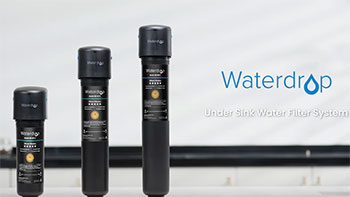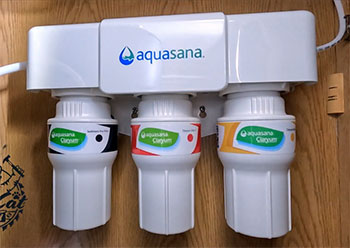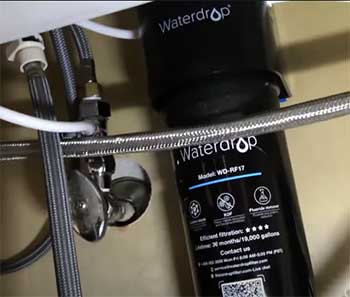In the ongoing search for pure, crisp-tasting water, the battle between under-sink water filters has reached a boiling point. Today, we’re going to put two market heavyweights to the test: Waterdrop and Aquasana.
Our deep dive into these systems will reveal their pros, cons, and everything in between. Buckle up; it’s time for a high-velocity splash into the world of under-sink water filters.
A Brief Comparison Table
| Features | Waterdrop | Aquasana |
| Filtration Capabilities | Reduces over 1,000 types | Removes 77 specific types |
| Flow Rate | 0.75 gallons per minute | 0.5 gallons per minute |
| Installation | Easy DIY installation | Might require professional |
| Filter Lifespan | Up to 12 months | Varies by model |
| Warranty | Limited 1-year warranty | 2-year warranty |
| Environmental Impact | Not specified | Eco-friendly filters |
The Pure Pour: Understanding Waterdrop
Waterdrop is a popular choice among consumers who prioritize effective filtration, modern design, and ease of use. But what’s the real deal?
Waterdrop Filtration Technology
Waterdrop filters use a 3-stage filtration system to deeply purify water:

Stage 1 – Sediment Pre-Filter: Removes sediment, rust, sand, and large particles
Stage 2 – GAC Carbon Block Filter: Reduces chlorine, benzene, mercury, asbestos fibers and more utilizing NSF certified coconut shell carbon.
Stage 3 – Reverse Osmosis Membrane: Eliminates heavy metals like lead and arsenic, dissolved solids, microplastics, pharmaceuticals, pesticides, and bacteria.
Waterdrop’s trademarked reverse osmosis membrane filters water down to 0.0001 microns, smaller than a virus. This thorough filtration removes up to 99% of total dissolved solids.
The end result is clean, refreshing drinking water free of dangerous contaminants. The filters are easy to install under your sink and replacement filters typically need to be swapped every 6-12 months depending on usage.
Let’s delve into its pros and cons.
Pros of Waterdrop Filters
- Exceptional Filtration: Waterdrop shines in its filtration prowess. It can reduce over 1,000 contaminants, including lead, fluoride, and a variety of harmful chemicals.
- Fast Flow Rate: With a filtration speed of 0.75 gallons per minute, Waterdrop ensures you’ll never wait for purified water.
- Simple Installation and Maintenance: Easy DIY installation and a long-lasting filter (up to 12 months) mean you spend less time worrying and more time enjoying pure water.
Cons of Waterdrop Filters
- Limited Lifetime Warranty: Waterdrop offers a limited one-year warranty, which might not be sufficient for some users.
- Single-Stage Filtration: Waterdrop uses a single-stage filter, which may not be as comprehensive as multi-stage systems in removing contaminants.
Aquasana: A Deep Dive into Clarity
Aquasana, another big player in the under-sink water filter market, offers a robust and efficient solution for clean drinking water. But does it hold water when compared to Waterdrop? Let’s check out the pros and cons.
Aquasana Filtration Process
Aquasana systems rely on a combination of carbon block filters and in some cases, UV light to remove impurities. Models vary from 2-7 filtration stages depending on the chosen system.
Here are some of the key filtration components:

Activated Carbon – Made from coconut shell carbon, it reduces chlorine, pesticides, industrial chemicals, pharmaceuticals and more through adsorption. NSF certified.
Sub-Micron Mechanical Filter – Traps cysts, sediment, asbestos fibers, particles.
Catalytic Carbon – Used as a polishing filter to further improve taste and odor.
UV Sterilizer – Destroys 99.99% of bacteria and viruses with powerful UV light in select models.
Ion Exchange – Reduces dissolved solids and improves mineral balance in some filters.
QED Resin – Binds to heavy metals like lead and mercury to reduce them to undetectable levels.
Like Waterdrop, Aquasana filters hook up under your sink. Filter cartridges typically need to be replaced every 6 months to 1 year depending on water usage and model.
Pros of Aquasana Filters
- Multi-Stage Filtration: Aquasana employs a 3-stage filtration process, efficiently removing 77 contaminants, including lead, mercury, pesticides, and more.
- Longer Warranty: Offering a generous 2-year warranty, Aquasana stands by their products for the long haul.
- Eco-Friendly: Aquasana’s eco-friendly filters contribute to reducing plastic waste, making it an environmentally-conscious choice.
Cons of Aquasana Filters
- Slower Flow Rate: With a flow rate of 0.5 gallons per minute, Aquasana is slower than Waterdrop, which could impact user experience.
- Complex Installation: Aquasana’s installation might be a bit tricky for some, potentially requiring professional help.
Key Differences Between Waterdrop and Aquasana Under-Sink Filters
While both Waterdrop and Aquasana are top-notch options in the realm of under-sink water filters, they exhibit some key differences that could be decisive factors depending on your needs.
- Filtration Capabilities

Waterdrop impresses with its broad spectrum of contaminants reduction, removing over 1,000 types.
On the flip side, Aquasana, with its 3-stage filtration system, efficiently eliminates 77 specific contaminants.
While the number might seem smaller, this includes some of the most common and harmful ones, such as lead, mercury, and pesticides.
- Flow Rate
In terms of dispensing purified water, Waterdrop’s faster flow rate (0.75 gallons per minute) means you’ll get your glass of water more quickly. Aquasana, in contrast, dispenses water at a slightly slower rate of 0.5 gallons per minute.
- Installation and Maintenance
If you’re a fan of DIY and don’t want to call in a professional, Waterdrop’s simpler installation process could be a selling point. Plus, its filters last up to 12 months, minimizing maintenance efforts.
Aquasana, on the other hand, may require professional help for installation, adding an extra step to the process.
- Warranty
Warranty could be a deciding factor for those who want extended protection for their investment. Here, Aquasana shines with its generous 2-year warranty. Conversely, Waterdrop offers a limited 1-year warranty, which could be a downside for those wanting longer coverage.
- Customer Reviews
Looking at customer feedback provides real world insights into how Waterdrop and Aquasana systems perform in homes.
Waterdrop – Reviews on various sites show consistently positive feedback. Customers praise the thorough filtration, improved taste, and simple maintenance.
Some reviews mentioned leaks being an issue. But Waterdrop provides good customer service support.

Aquasana – The majority of reviews are 4 and 5-stars. Happy customers say the filters deliver great tasting water and work as expected. A few complaints crop up about filters not lasting long enough. Support assists with any issues.
For both brands, the vast majority of home users are very satisfied with the filtration results and see noticeable improvements in their water quality, taste and odor after installing the system.
- Environmental Impact
For those conscious about their environmental footprint, Aquasana’s eco-friendly filters reduce plastic waste, making it a greener choice. While Waterdrop doesn’t explicitly promote eco-friendly filters, it’s still a reliable and effective choice for water filtration.
In the end, your unique needs, priorities, and lifestyle will be the deciding factors in choosing the best under-sink water filter for you. Both Waterdrop and Aquasana have a lot to offer, so weigh these key differences carefully before making your choice.
While both Waterdrop and Aquasana deliver in terms of providing purified, great-tasting water, the best filter for you depends on your specific needs. If you value speed and simplicity, Waterdrop might be your winner.
However, if multi-stage filtration and a longer warranty are your top priorities, Aquasana could be the better choice.
Recommendations
So in the battle of Waterdrop vs Aquasana, which brand comes out on top?
For the most thorough filtration of contaminants, Waterdrop has the edge. The reverse osmosis membrane removes the widest array of impurities, including very small particles that Aquasana filters cannot trap. So Waterdrop is the best choice if completely eliminating things like microplastics and viruses is your top priority.
However, Aquasana offers much greater flexibility in model selection and budget options. An Aquasana countertop or under sink system runs at a significantly lower price point than Waterdrop equivalents. So if affordability is your main concern, Aquasana provides impressive filtration capabilities at a more budget friendly cost.
Ultimately, it comes down to your specific needs and priorities. For a lower priced yet effective system, Aquasana is hard to beat. But if you want the most extensive water filtration available for home use, Waterdrop reverse osmosis systems are worth the extra investment.
Either way, both provide vast improvements in water quality and help ensure the water you drink is as safe and clean as possible. We hope these insights help steer you toward the best system for your home and family!
Frequently Asked Questions (FAQ)
There’s no one-size-fits-all answer. The best water filter depends on your needs, budget, and priorities. Both Waterdrop and Aquasana have unique benefits, as do other brands like Berkey and PUR.
Besides Waterdrop, other Aquasana alternatives include Berkey, PUR, Brita, and iSpring. Each of these brands offers unique features, so it’s crucial to research and compare based on your specific needs.
The Waterdrop G3 Under Sink Water Filter is highly rated for its advanced filtration capabilities, fast flow rate, and ease of use.
In general, reverse osmosis systems, like the ones offered by Waterdrop, Aquasana, and iSpring, tend to remove the most contaminants. However, keep in mind that the type and number of contaminants a filter can remove also depend on its specific design and technology.
Yes, Waterdrop filters are highly effective and use top quality materials. Their 3-stage reverse osmosis system removes over 99% of impurities, including lead, chlorine, microplastics, and pharmaceuticals. Customer reviews praise Waterdrop for improving water taste and quality. Their filters meet NSF standards and are WQA certified.
Waterdrop was founded in China in 2016 and their filters are assembled in China. However, Waterdrop emphasizes they use globally certified parts from world renowned brands like GE, Dupont, LG, Hydranautics and others. Their filters meet all US quality and safety regulations.
Wrapping Up
In the end, the choice between Waterdrop and Aquasana will boil down to your specific needs and preferences.
Remember, the best under-sink water filter is the one that fits seamlessly into your lifestyle, meets your filtration needs, and gives you the peace of mind that every glass of water you drink is pure, safe, and delicious.
Stay hydrated!
